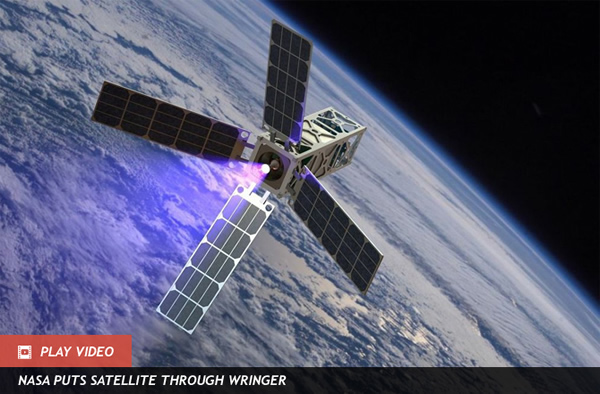Tiny Robotic Cubes Could Rule the Solar System
Tiny Robotic Cubes Could Rule the Solar System
Launching stuff into space is an expensive business, but what if we were able to miniaturize an entire spacecraft into the size of a loaf of bread? According to a pair of engineers from the University of Michigan who have just begun a Kickstarter campaign to get their concept funded, an armada of tiny low-cost probes could be sent on interplanetary missions to destinations we can currently only dream about.
As our technology becomes more sophisticated, it shrinks. This is obviously a good thing for space technology — the cost to launch mass into orbit is often painfully very high. So, in recent years, the world has seen an uptick in launches of little satellites called ‘cubesats.’ These small satellites have been game changers for groups and institutions that don’t have the financing of a small nation to get their experiments into space. Cubesats are so small that they can piggyback on rockets launching larger payloads. The costs for getting small space research projects have therefore plummeted from millions to thousands of dollars.
The University of Michigan team has been launching cubesats into orbit since 2008, but now they’ve set their sights farther afield — they are developing a miniaturized propulsion system that will turn the cubesat into a propulsive cubeship. Interplanetary space is their goal, potentially giving us a glimpse of what a future mission to Mars or even Jupiter’s moon Europa will really look like.
“If we wanted to try a mission like what we’re proposing with current technology, we wouldn’t even make it out of Earth orbit,” said Benjamin Longmier, assistant professor at the Plasmadynamics and Electric Propulsion Lab (PEPL) in the College of Engineering. “We have some little thrusters called gas jets that will push us a little bit, but what we want to do is be able to push our spacecraft millions of miles from Earth and go truly interplanetary.”
“The problem with the spacecraft we currently build is they don’t move,” said James Cutler, assistant professor and director of the Michigan Exploration Laboratory (MXL). “And there are some very interesting places that we’d like to go. So Ben’s come along and hopefully we can combine these two efforts and go to some very interesting places.”
Cutler’s team has been selected by NASA’s Jet Propulsion Laboratory (JPL) to be part of the Interplanetary NanoSpacecraft Pathfinder In Relevant Environment (INSPIRE) mission, which aims to demonstrate survivability, communication, tracking and payload hosting with two CubeSats dropped off in deep space by a larger rocket, says the University of Michigan press release. This means that small cubesats need to be built to survive in the high-radiation environment beyond the Earth’s protective magnetic field. This is an interesting challenge as the team will need to find a balance between fitting all the instrumentation into a very small frame while still building in sufficient shielding.
But the INSPIRE cubesats will not carry any propulsion technology; once they are dropped off by a rocket in space, they’ll just drift along until their energy reserves run out.
So Longmier and Cutler want to give their interplanetary explorers the capability to cruise through interplanetary space, thereby evolving the cubesat paradigm.
Ion thrusters are in use by space missions today — NASA’s Dawn mission to the asteroid Vesta, for example, is now on its way to dwarf planet Ceres under the thrust provided by an ion drive. Currently, however, ion drives or plasma thrusters rely on xenon or krypton gas as fuel. Storage of this gas requires tanks that would be impractically huge for the diminutive cubesat. So Longmier is developing an ingenious new fuel source that can be stored as a liquid inside a tank that can fit inside a cubesat.
The tiny plasma drive — called the CubeSat Ambipolar Thruster (CAT) — will ionize water or iodine liquid fuel, thereby turning it into a gas or plasma. Then, like other plasma drives, powerful electric fields will accelerate the plasma to high speed through a magnetic “virtual nozzle.” This tiny plasma engine has the potential to operate for long periods in space, suddenly making interplanetary jaunts a possibility.
Early interest by groups, such as asteroid mining company Planetary Resources, is being reported. After all, wouldn’t it be nice if we could have small, cheap, yet highly capable cubesats prospecting asteroids before mining operations commence?
Developing this tiny plasma thruster requires money, but going the traditional route of acquiring a large government grant can be troublesome. To compress the developmental timeframe, while growing a community spirit around the endeavor, the engineers are using the crowd-funding platform Kickstarter to raise $200,000. With this money, they hope to see an operational cubeship in space within 18 months.
“We really want to put the participatory experience in everyone’s hands,” Longmier said. “We’d like to open it up to the community and have people be a part of the process.”
Let’s face it, exploring some of the most interesting planets and moons in the solar system currently requires the biggest budgets on Earth to achieve. Wouldn’t it be awesome if we saw a fleet of tiny exploring cubes set off on a mission to Europa, all working in tandem to analyze the moon’s life-giving potential, for the cost of a university grant rather than a chunk of NASA’s annual budget?
Image: Artist’s impression of the CAT in operation on board a cubesat above Earth. Credit: Univ. of Michigan(Jul 8, 2013 12:47 PM ET // by Ian O'Neill)












